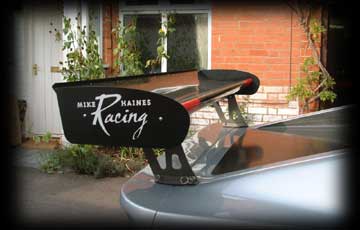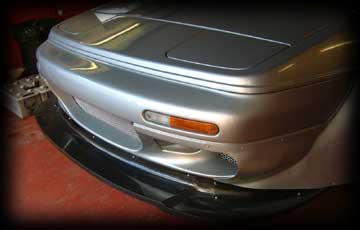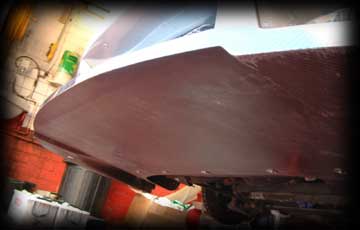After deciding to replace both the rear deck and doors with carbon fibre versions, these items were prepared from the original moulds. MHR have moulds for all Esprit GT1 body-panels. It was agreed that the original oval vents from the Sport350 would be fitted into the carbon deck. On the race car, the engine cover is physically lifted off to gain access to the engine compartment. For my application, it became necessary to design a special tilting mechanism for the rear wing. This allowed for the necessary clearance for the rear deck to operate on a single hydraulic strut. The rear wing is mounted directly onto the rear body to allow the down-force to act directly to the rear bodywork and not through the engine cover.



There are two versions of rear wing used on the race car – high and medium down-force. The high down-force rear wing has a very deep profile and an extended rear edge. There is also a Gurney flap on the trailing edge. This medium down-force wing has a similar profile to the Sport350 wing, but is a little deeper. The original Sport350 rear wing belonged to the Type 115 (Elise GT1) which has a very different body profile to the Esprit. The high down-force wing was selected for the project.


The roof panel has been replaced with a carbon version and houses the roof NACA duct for the transmission oil cooler. The duct offers a low-pressure path for air travelling over the top of the car and directs it through a 12 row Mocal oil cooler.

An additional NACA duct is located above the left-hand rear wing. This is for the potential of an additional transmission oil cooler (for the race engine) and is currently used to direct cool air to the exhaust outlets.

The doors were replaced with an open carbon shell – this maximised the weight saving and also further exaggerate the ‘race’ feel of the interior. The door armatures were also machined out to reduce weight further (without losing the necessary strength) and finally polycarbonate windows were designed. The drivers window has a lockable sliding aperture. There is an additional carbon cover panel to close of the door internal (optional).



The GT1 race car has a wider front and rear track. The front wheel arches contain additional venting on the rear face of the arch. This is to increase airflow through the arch for brake cooling.

Another major feature on the race car is the front splitter. It was agreed to create a version of the splitter with a shortened floor. The race car has a full-length flat floor for creation of significant down force at higher speeds. The front splitter is solid and dictates the road going ride height. This can be reduced significantly for track days, but will need to be tailored to the circuit.


The rear arch extensions cover the significant increase the rear width of the car. To protect these from debris passed through the front arch vents, it was necessary to protect them with ‘helicopter rotor tape’.


On the race car the flat floor extends to the sides and mates with the doorsill. In conjunction with the wheel arch extension, second lower sill extensions were added. This second lower sill was added initially for aesthetic reasons, as it keeps the profile of the central part of the car at the same depth as the front splitter. But will also reduce the amount of air under the car.
The rear diffuser was designed to create additional down-force on the rear. Again, a shortened floor version was employed. After looking at the diffuser, it was agreed that a customised exhaust set-up would be needed. This would replicate the race car with two central exits above the diffuser.



The front dive planes were added to complete the aerodynamic modifications. The whole package of ´steroidal´ body panels and aerodynamic aids make the project car a real eyeful. The external look of the project is now pretty much identical to the GT1, with the exception of the front bonnet which doesn´t have the main radiator outlet.

|
|